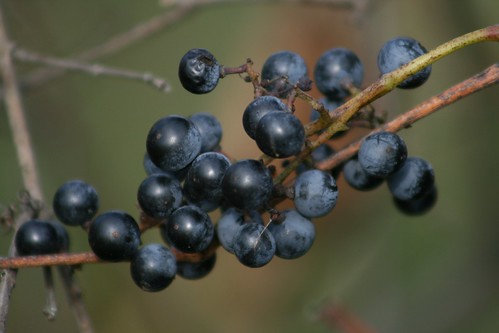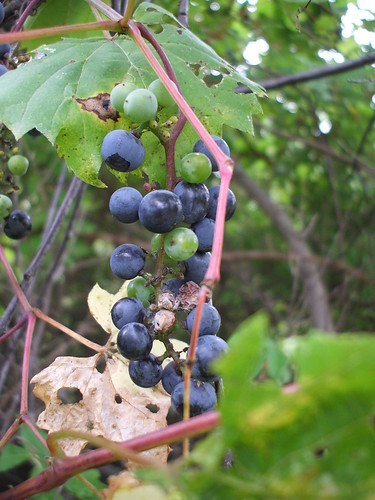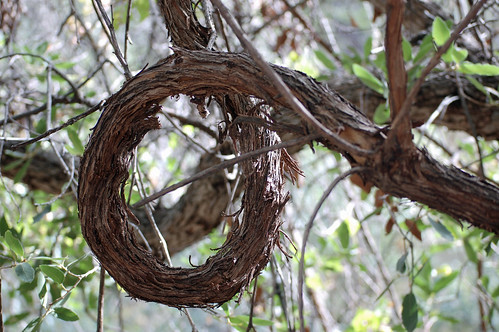 I had a book of Aesop's Fables as a child, and the story I remember best is the story of the Fox and the Grapes. There's a big, juicy bunch of grapes hanging from a vine, and a fox is trying as hard as he can to get to them, but just can't quite reach. When he gives up, the fox says, "I don't want those grapes anyway -- they're probably sour!"
I had a book of Aesop's Fables as a child, and the story I remember best is the story of the Fox and the Grapes. There's a big, juicy bunch of grapes hanging from a vine, and a fox is trying as hard as he can to get to them, but just can't quite reach. When he gives up, the fox says, "I don't want those grapes anyway -- they're probably sour!"Sounds like the wild grapes of ancient Greece weren't too different from our own -- very tempting but very sour. Our native grapes are also very small. But we like them anyway...and like the fox in Aesop's fable, we'll go to some lengths to get some every fall.
 Before you try to eat wild grapes, be confident in your identification. The leaves can be quite varied in size and shape, but generally have roughly toothed edges. The leaves may have three distinct lobes, or they may just hint at them. The vines climb with distinctive, curly tendrils that wrap around whatever they can for support. As they get older, the vines shed their bark, giving them a shredded texture. It's not uncommon to see thick, peeling grapevines reaching far up into the canopy -- they've kept pace with the tree they're hanging from, making sure they can get sun for their leaves even as the tree puts on new growth.
Before you try to eat wild grapes, be confident in your identification. The leaves can be quite varied in size and shape, but generally have roughly toothed edges. The leaves may have three distinct lobes, or they may just hint at them. The vines climb with distinctive, curly tendrils that wrap around whatever they can for support. As they get older, the vines shed their bark, giving them a shredded texture. It's not uncommon to see thick, peeling grapevines reaching far up into the canopy -- they've kept pace with the tree they're hanging from, making sure they can get sun for their leaves even as the tree puts on new growth. But you're looking for fruit that's within reach, which will likely be on younger vines. Clusters of wild grapes look something like miniature clusters of cultivated grapes. When ripe, they are dark purple, but (like cultivated grapes) they may have a blush of yeast on them that makes them look a little lighter. They have multiple crunchy seeds which take up a lot of the fruit. But the fruit that is there has an intense flavor.
But you're looking for fruit that's within reach, which will likely be on younger vines. Clusters of wild grapes look something like miniature clusters of cultivated grapes. When ripe, they are dark purple, but (like cultivated grapes) they may have a blush of yeast on them that makes them look a little lighter. They have multiple crunchy seeds which take up a lot of the fruit. But the fruit that is there has an intense flavor. There are several other small, purple fruits in the fall. Make sure you rule these out -- none of them are edible, and some are quite poisonous: virginia creeper (which has leaves made of five leaflets, and red stems on the fruit), Canada moonseed (whose leaves are a similar shape to grapes, but smooth, not toothed; each fruit has a single, moon-shaped seed), porcelain berry (also has grape-like leaves, but the berries are blue and white before ripening, not green like unripe grapes), and pokeweed (not a vine, but it can be mixed into thickets that also include grapes; fruits branch off a very straight stalk that's often reddish).
Enough warnings. We've taught 3-year-olds to reliably recognize wild grapes...you can do it too.
 In the wild: Wild grapes need some sunlight to fruit well but they also like the support of trees. They generally thrive where there has been a disturbance in the forest canopy, or on the trees on the edge of a forest. There are tons of grapes out there that you have no hope of reaching, but every once in a while, a younger vine will have some fruit low enough for you to get a taste.
In the wild: Wild grapes need some sunlight to fruit well but they also like the support of trees. They generally thrive where there has been a disturbance in the forest canopy, or on the trees on the edge of a forest. There are tons of grapes out there that you have no hope of reaching, but every once in a while, a younger vine will have some fruit low enough for you to get a taste.In your yard: Wild grapes are a lot easier to grow than cultivated grapes, in the sense that they don't get as many pests and diseases. But the vines can grow up to 75 feet long. They'll do best in full sun, on a trellis. You can also try a more naturalistic planting, as long as there's something for the tendrils to wrap around for support.
Like the photos in this post? Mouse over for credits; a click takes you to the photographer on Flickr.


